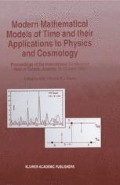Abstract
Our Universe consistes of particles, space and time. Ever since Descartes we have known that true emptiness cannot exist; ever since Einstein we have known that space and time are part of the stuff of our world. Efforts to determine the structure of particles go in parallel with the search for the structure of spacetime. Einstein gave us a geometrical answer regarding the structure of spacetime: a distance recipe (Lorentz-Minkowski) suffices. The theory boils down to a patching together of local Lorentz frames into a global whole, which gives it the form of a gauge field theory based on local Lorentz symmetry. On large scales, the Einstein Equation seems to work well. The structure of particles is described by a gauge field, too. On small scales the ‘Standard Model’ seems to work very well.
However, we know from Newtonian gravity that the presence of particles must be related to the structure of spacetime. Einstein made a conjecture for the form of this connection using the Newtonian limit of small speeds and weak fields. The right hand side of his equation for the bulk theory of matter (the energy-momentum tensor), is equated to the Einstein tensor from non-Euclidian geometry.
But that connection is wrong. The structure of spacetime cannot be equated to the density of particles if we include the Standard Model in the matter tensor. In field theory a potential is not something that can be freely changed by adding an arbitrary scalar term; due to the local (as opposed to global) character of the fields, a potential becomes an entity in itself. Einstein’s conjecture runs into profound trouble because the reality of potentials implies that the zero point energy of the vacuum must be included in the Einstein equation. The net result is the appearance of a term equivalent to a cosmological constant A of stupendous size, some 10118 times the critical cosmic density.
The crisis due to the zero point fluctuations in the energy-momentum tensor is a clash of titans: Einstein’s geometrical ideas on spacetime structure vs the behaviour of particles and the vacuum discribed by Dirac and followers. Someone, or everyone, is wrong. In my opinion the straightforward quantization of spacetime will always be impossible because the usual particle symmetries (U(1), SU(2), SU(3) and relatives) connect fermions and bosons, whereas relativistic analogies of these symmetries (the Lorentz symmetry) says something about spacetime and not about particles.
Access this chapter
Tax calculation will be finalised at checkout
Purchases are for personal use only
Preview
Unable to display preview. Download preview PDF.
References
Icke, V.: 1995, The Force of Symmetry, Cambridge University Press, Cambridge
Utiyama, R.: 1956, Phys. Rev. 101, 1597–1607
Weinberg, S.: 1989, Revs. Mod. Phys. 61, 1–23
Author information
Authors and Affiliations
Editor information
Editors and Affiliations
Rights and permissions
Copyright information
© 1997 Springer Science+Business Media Dordrecht
About this paper
Cite this paper
Icke, V. (1997). Particles, Space, and Time. In: Tifft, W.G., Cocke, W.J. (eds) Modern Mathematical Models of Time and their Applications to Physics and Cosmology. Springer, Dordrecht. https://doi.org/10.1007/978-94-011-5628-8_25
Download citation
DOI: https://doi.org/10.1007/978-94-011-5628-8_25
Publisher Name: Springer, Dordrecht
Print ISBN: 978-94-010-6372-2
Online ISBN: 978-94-011-5628-8
eBook Packages: Springer Book Archive

